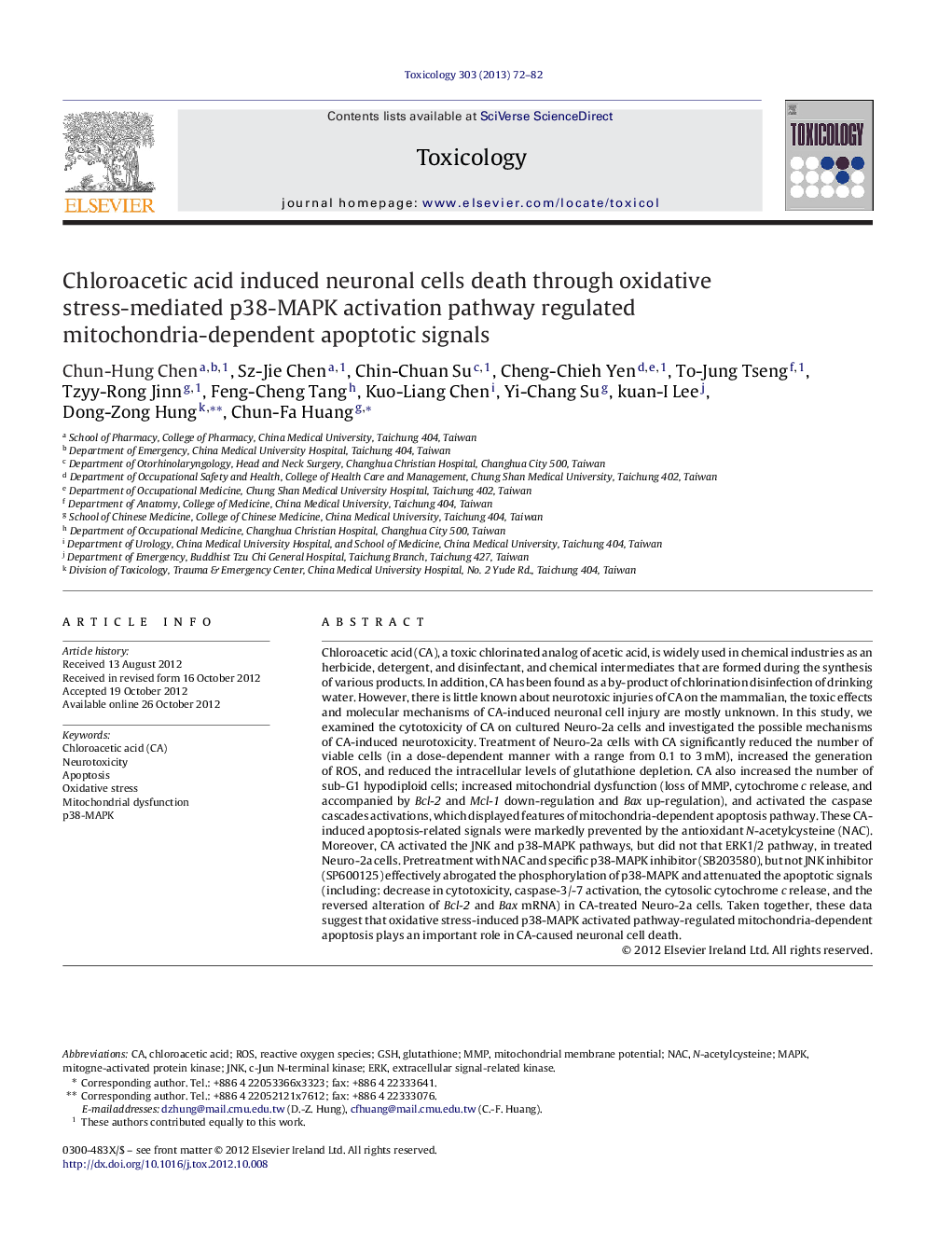| کد مقاله | کد نشریه | سال انتشار | مقاله انگلیسی | نسخه تمام متن |
|---|---|---|---|---|
| 5859472 | 1562353 | 2013 | 11 صفحه PDF | دانلود رایگان |
عنوان انگلیسی مقاله ISI
Chloroacetic acid induced neuronal cells death through oxidative stress-mediated p38-MAPK activation pathway regulated mitochondria-dependent apoptotic signals
دانلود مقاله + سفارش ترجمه
دانلود مقاله ISI انگلیسی
رایگان برای ایرانیان
کلمات کلیدی
MMPJnkGSHNACERKc-Jun N-terminal kinase - C-Jun N-terminal kinaseMAPK - MAPKN-acetylcysteine - N-استیل سیستئینp38-MAPK - p38-mapkROS - ROSMitochondrial dysfunction - اختلال در عملکرد میتوکندریchloroacetic acid - اسید کلرواسپیکOxidative stress - تنش اکسیداتیوApoptosis - خزان یاختهایNeurotoxicity - سمیت عصبیMitochondrial membrane potential - پتانسیل غشای میتوکندریextracellular signal-related kinase - کیناز مرتبط با سیگنال خارج سلولیGlutathione - گلوتاتیونReactive oxygen species - گونههای فعال اکسیژن
موضوعات مرتبط
علوم زیستی و بیوفناوری
علوم محیط زیست
بهداشت، سم شناسی و جهش زایی
پیش نمایش صفحه اول مقاله

چکیده انگلیسی
Chloroacetic acid (CA), a toxic chlorinated analog of acetic acid, is widely used in chemical industries as an herbicide, detergent, and disinfectant, and chemical intermediates that are formed during the synthesis of various products. In addition, CA has been found as a by-product of chlorination disinfection of drinking water. However, there is little known about neurotoxic injuries of CA on the mammalian, the toxic effects and molecular mechanisms of CA-induced neuronal cell injury are mostly unknown. In this study, we examined the cytotoxicity of CA on cultured Neuro-2a cells and investigated the possible mechanisms of CA-induced neurotoxicity. Treatment of Neuro-2a cells with CA significantly reduced the number of viable cells (in a dose-dependent manner with a range from 0.1 to 3Â mM), increased the generation of ROS, and reduced the intracellular levels of glutathione depletion. CA also increased the number of sub-G1 hypodiploid cells; increased mitochondrial dysfunction (loss of MMP, cytochrome c release, and accompanied by Bcl-2 and Mcl-1 down-regulation and Bax up-regulation), and activated the caspase cascades activations, which displayed features of mitochondria-dependent apoptosis pathway. These CA-induced apoptosis-related signals were markedly prevented by the antioxidant N-acetylcysteine (NAC). Moreover, CA activated the JNK and p38-MAPK pathways, but did not that ERK1/2 pathway, in treated Neuro-2a cells. Pretreatment with NAC and specific p38-MAPK inhibitor (SB203580), but not JNK inhibitor (SP600125) effectively abrogated the phosphorylation of p38-MAPK and attenuated the apoptotic signals (including: decrease in cytotoxicity, caspase-3/-7 activation, the cytosolic cytochrome c release, and the reversed alteration of Bcl-2 and Bax mRNA) in CA-treated Neuro-2a cells. Taken together, these data suggest that oxidative stress-induced p38-MAPK activated pathway-regulated mitochondria-dependent apoptosis plays an important role in CA-caused neuronal cell death.
ناشر
Database: Elsevier - ScienceDirect (ساینس دایرکت)
Journal: Toxicology - Volume 303, 7 January 2013, Pages 72-82
Journal: Toxicology - Volume 303, 7 January 2013, Pages 72-82
نویسندگان
Chun-Hung Chen, Sz-Jie Chen, Chin-Chuan Su, Cheng-Chieh Yen, To-Jung Tseng, Tzyy-Rong Jinn, Feng-Cheng Tang, Kuo-Liang Chen, Yi-Chang Su, kuan-I Lee, Dong-Zong Hung, Chun-Fa Huang,